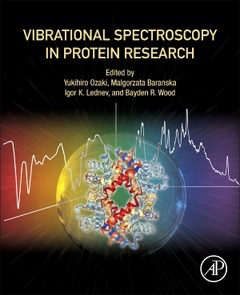Description
Vibrational Spectroscopy in Protein Research
From Purified Proteins to Aggregates and Assemblies
Coordinators: Ozaki Yukihiro, Baranska Malgorzata, Lednev Igor K., Wood Bayden R.
Language: English
Subjects for Vibrational Spectroscopy in Protein Research:
Keywords
?2D-COS; ATR-FTIR imaging; Abnormal protein aggregation; Allostery; Amide II modes; Amyloid; Amyloids; Attenuated total reflection; Bioconjugation; Biospectroscopy; Biotin; Blood plasma proteins; Blood storage; Bovine serum albumin; Cancer diagnosis; Cardiovascular disease; Cartesian coordinate-based transfer; Chemometrics; Chemosensors; Chromophore; Corona; Density functional theory; Diabetes; Diagnostics; Difference FTIR spectra; Disease diagnosis; Endothelium; Ex vivo; FTIR; FTIR spectroscopy; Fibrils; Gold nanoparticles; Hemoglobin; Hot spot; Human serum albumin; Hydration; Hydrogen bond; ISERS assay; ISERS microscopy; Immuno-SERS; In vitro; Infrared; Infrared microspectroscopy; Infrared nanospectroscopy; Infrared spectroscopy; Ion transport; Iron-containing proteins; MCR-ALS; Malaria; Markov state models; Molecules-in-molecules method; NIR spectroscopy; Nanolens; Near-infrared; Neurodegeneration; N–H stretching vibration; Optical tweezers; Optogenetics; Oxidative damage; Patient monitoring; Plasma; Plasmonic nanostructures; Prognosis; Protein; Protein aggregation; Protein aggregation kinetics; Protein characterization; Protein crystallization; Protein dynamics; Protein folding/unfolding; Protein imaging; Protein markers; Protein misfolding; Protein quantification; Protein research; Protein structural changes; Protein structure; Protein-bound water molecules; Proteins; Quantification; Quantum cascade laser; Raman; Raman optical activity; Raman reporter molecules; Raman spectroscopy; Red blood cell; Resonance Raman spectroscopy; SERS; Secondary structure; Serum; Signal transduction; Spectra simulations; Stochastic Liouville equation; Streptavidin; Sum-over-states; Surface-enhanced Raman scattering; Surface-enhanced hyper Raman scattering; Synchrotron; Time-resolved; Time-resolved resonance Raman spectroscopy
608 p. · 19x23.3 cm · Paperback
Description
/li>Contents
/li>Readership
/li>Biography
/li>Comment
/li>
Vibrational Spectroscopy in Protein Research offers a thorough discussion of vibrational spectroscopy in protein research, providing researchers with clear, practical guidance on methods employed, areas of application, and modes of analysis. With chapter contributions from international leaders in the field, the book addresses basic principles of vibrational spectroscopy in protein research, instrumentation and technologies available, sampling methods, quantitative analysis, origin of group frequencies, and qualitative interpretation. In addition to discussing vibrational spectroscopy for the analysis of purified proteins, chapter authors also examine its use in studying complex protein systems, including protein aggregates, fibrous proteins, membrane proteins and protein assemblies.
Emphasis throughout the book is placed on applications in human tissue, cell development, and disease analysis, with chapters dedicated to studies of molecular changes that occur during disease progression, as well as identifying changes in tissues and cells in disease studies.
1. ATR-FTIR Spectroscopy and Spectroscopic Imaging of Proteins 2. Light-Induced Difference FTIR Spectroscopy of Photoreceptive Proteins 3. Quantum Cascade Laser-based IR Transmission Spectroscopy of Proteins in Solution 4. Theoretical Simulation of Protein Two-Dimentional Infrared Spectroscopy 5. Infrared Spectroscopy and Imaging for Understanding Neurodegenerative Protein-Folding Diseases 6. Near-infrared (NIR) spectroscopy in protein research 7. Vibrational imaging of proteins: changes in the tissues and cells in the lifestyle disease studies 8. Interpretation of Vibrational Optical Activity Spectra of Proteins 9. Nano-scale analysis of protein self-assemblies 10. Vibrational Spectroscopic Analysis and Quantification of Proteins in Human Blood Plasma and Serum 11. Vibrational spectroscopy in protein research towards virus identification: challenges, new research and future perspectives 12. Two-Dimensional Correlation Spectroscopy of Proteins 13. Resonance Raman spectroscopy of hemoglobin in red blood cells 14. Ultraviolet Raman spectroscopy for understanding structure and formation mechanism of amyloid fibrils 15. Recent advances in Raman spectroscopy of proteins for disease diagnosis 16. Dynamics and allostery of human hemoglobin as elucidated by time-resolved resonance Raman spectroscopy 17. Immuno-SERS: from nanotag design to assays and microscopy 18. Highly localized characterization of protein structure and interaction by surface-enhanced Raman scattering 19. Surface-enhanced Raman scattering (SERS) chemosensing of proteins
Dr. Malgorzata Baranska leads the Raman Imaging Group at The Jagiellonian University, Kraków, Poland. In her research, Dr. Baranska focuses on analyzing bioactive compounds using spectroscopic methods, particularly modern Raman techniques. The main direction of her research is related to development treatments for life style diseases, including new drugs of endothelium bioactivity.
Dr. Igor Lednev received his PhD degree from The Moscow Institute of Physics and Technology, Russian Federation before joining the University of Albany as faculty. As an academic visitor, he worked in several leading laboratories around the world including the United Kingdom, Japan, Canada, and Germany. Dr. Lednev’s current research is focused on the development and application of novel laser spectroscopy for biomedical and forensic applications.
Dr. Bayden R. Wood is an Australian Research Council Future Fellow working at the Centre for Biospectroscopy located in the School of Chemistry, Monash University, Malborne, Aust
- Provides thorough guidance in implementing cutting-edge vibrational spectroscopic methods from international leaders in the field
- Emphasizes in vivo, in situ and non-invasive analysis of proteins in biomedical and life science research more broadly
- Contains chapters that address vibrational spectroscopy for the study of simple purified proteins and protein aggregates, fibrous proteins, membrane proteins and protein assemblies




